Lauren Ko, pie and tart artist
The spoke pie that went viral, why you should grill your pineapple, and the story of her bestselling cookbook
The story of Lauren Ko’s pie that went viral seems so incredible that, even five years later, Lauren herself is still amazed. That the story of a home baker becoming an instant culinary star hasn’t been made into a stylish movie with saturated colors, geometric graphics, and a springy, upbeat soundtrack is even more surprising.
If there was such a movie, the screenplay would unfold like this: You would see Lauren toiling by day at an uninspired desk job. And then one day after work, she goes home and spontaneously decides to bake a pie, even though she’s never really made one before and doesn’t have much of a sweet tooth. There might also be a “pie fail” scene that was mortifying to Lauren at the time, but now is a funny memory (more about that later).
As the movie based on real life continues, you see a time-lapse montage of Lauren making pies and photographing them. She creates @lokokitchen on Instagram in August 2017. In the fictional movie, you see Lauren painstakingly place triangles of kiwi fruit with a tweezer onto a pie and then take an aerial photograph, standing precariously on a bar stool. You witness her post online a series of pics—pies topped with geometric shapes and intricate weaving—unapologetically accompanied by pun-laden captions. Her posts get hundreds of likes and Lauren is stunned by the attention.
Next scene in the movie: the calendar page flips to show a month has passed and @lokokitchen has 1,000 followers. Another page flip and we see that the online design publication Design Milk shared the post of her spoke design pie, yielding 8,000 followers in one day. Next, you see Lauren on television, showing the Martha Stewart how to make a pie, and appearing in the pages of Oprah’s magazine. By December she has more than 100,000 followers and everyone wants a piece of Lauren’s pie. She’s a self-described introvert and nerd, so all this attention is overwhelming.
As the movie progresses, Lauren quits her sad desk job, gets a book deal, comes to peace with haters on social media, and writes a 50-recipe cookbook. The imagined movie (produced and distributed, by the way, by Palate & Palette Media, LLC) concludes in mid-2020 with Lauren returning from walking her dog Santi to find an advance copy of her stunning book titled Pieometry on her porch.
Now that I’ve given you some backstory in pretend movie form, I have this introductory comment about Lauren’s book. She received a lot of attention for the visual aspects of her pies, but their flavor combinations are just as spectacular: ginger peach mango with butter and beet crust, honey ricotta beet in herbed crust, butternut bacon mac and cheese with cheddar chive crust, malted chocolate banana cream pie with Nutella crust, and so many more...
Boston area readers! You can celebrate Pi Day and meet Lauren on March 14, 2023! Details here…
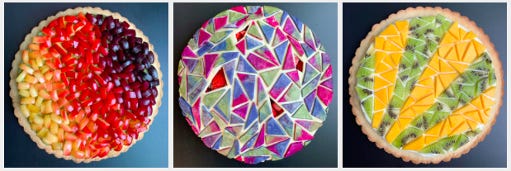
All photos in this story are from Lauren Ko unless noted otherwise.
Did you cook and bake as a child?
I come from a family of phenomenal eaters. I was surrounded by wonderful home cooks and we enjoyed lots of great meals, all the time. I didn't really take to cooking until after college when I had to cook for myself out of necessity. I became interested in baking for fun as an outlet and a vehicle for feeding the people I love.
What are some of your childhood memories of food?
My mom is Chinese, but she was born and raised in Honduras. It’s a crazy immigration story of my great grandparents who ended up in Central America.
As a child, I visited my grandparents every summer and every Christmas. We ate a lot of—I wouldn't say fusion—but the best food from both worlds. My grandmother cooks these really delicious, elaborate Chinese feasts, but also made a lot of local [Honduran] cultural cuisine.
One of my favorite foods growing up was enchiladas, which are different from the Mexican enchiladas. You start with a fried tortilla, put meat on it, and top it with pickled cabbage, a slice of tomato, and grated stinky cheese.
We would pick mangoes from the trees in my grandparents’ yard. I like mangoes that are sweet, but my favorite is eating them green; they're crunchy and sour and you dip them in salt and pepper and cumin. I crave that because I can't find green mangoes in the US that are sour enough.
Did you did you make art as a child? Did you knit or weave or draw?
I didn’t do many crafts growing up, but I always loved drawing. I took a lot of art classes in middle school and high school and enjoyed them, but never really considered art something I would pursue as an adult, much less professionally.
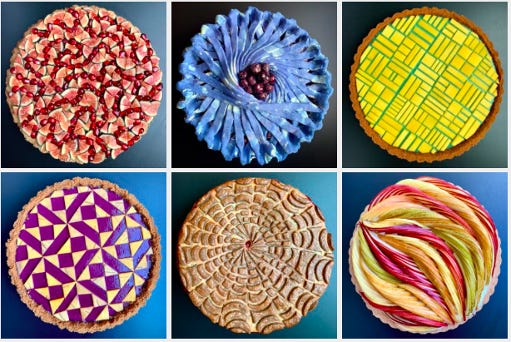
The inside covers of your book have drawings of pies and tarts. Do you sketch your creations before you make them?
I'm a very visual person. When I finalized a recipe for the book, my reward was to sketch the design of the completed pie and put it on my office wall. This also helped me get a macro view of the designs I had for the book and see if there was a balance of color and design styles.
I usually don’t sketch out designs beforehand unless I'm working with a brand [she does some partnerships with food and cooking-related companies] or a company that needs to see a few drafts. When I've tried to sketch things out or I have a detailed picture in my mind, I tend to get frustrated because fruit and pie dough don't always cooperate.
In the headnotes, your recipes are linked to specific life experiences and travels. What is one example of a flavor or ingredient combination inspired by your travels?
The grilled cinnamon pineapple pie in my book is one of my favorites and is inspired by being in Honduras. My extended family on my mom’s side would gather for carne asada barbecue parties. We would have grilled cinnamon pineapples—either the pineapple rings, or pineapple chunks—sprinkled with cinnamon sugar and charred directly over the grill so they get super caramelized. I often make the grilled cinnamon pineapple pie when I do my workshops [Lauren teaches classes and speaks at events]. Grilling pineapple is a revelation and most people don’t think to make it that way. And it's easy! You can broil it in the oven or grill it.
Your book has puns for recipe titles instead of the actual name of the pie, such as “Happy as a Gram” or “Berried Treasure.” How did that come about?
That was accidental, just like this entire journey. The first photo I shared was a geometric pie with a really cheesy dad joke word-play caption. When the account went viral, I would get a lot of comments from people saying, “I'm here for the pies, but I'm also here for the puns,” so I kept that going in the captions. [Some early captions: “A breath of fresh pear,” “Cluck bait” (for a chicken pot pie), “Love makes the swirled go round” for a pie topped with a swirl of apricot slices, “Resting peach face,” and “Quince you been gone.”]
The word play became part of my online voice and I wanted to include that in the book. There's a Russian translation of the book, which obviously I can't read, but I'm really curious how it reads.

Where do you get your ideas and design inspiration?
Most of the inspiration sources for the pies in the book as well as on my Instagram are from unexpected sources, generally not food related. As an example, the Sun in a Million pie looks like a sun with the dragon fruit crust and the strips are orange. That was inspired by a bamboo purse.
Some tile designs were inspired by public bathroom tile floors, furniture, and even storm drains. I’ll notice the way the shadows create interesting angles and geometric shapes and craft that into a design.
How did your book come to be?
I blacked out and resurfaced and there was the book [she jokes].
I received emails from publishers and literary agents. Before, the thought of writing a book had never even occurred to me. I didn't know anything about the publishing industry or how one would go about writing a book. Eventually I had calls with every single person who reached out and tried to get as much information as I could about writing a book.
I figured out that I needed an agent. After meeting with three, I signed with Katherine Latshaw [who she describes as a badass and hot pink in a world of grays] and she helped me develop a book proposal. We shopped that proposal around and it went to auction, which meant that multiple publishers were interested in making offers. I signed a contract with William Morrow and they gave me nine months to produce a manuscript.
What were those nine months like? How did you do it?
It was a stressful and chaotic time because I was learning all these things as I was doing them.
I spent nine months working seven days a week, 16-hour days. I started with a list of recipes and flavors that I thought would be interesting. Every day I would test a couple different recipes. Some worked on the first few tries, and others I would have to test all week. It was a crazy time of going to Costco and buying obscene quantities of ingredients and stashing them all over my house.
I had to develop at least 60% brand-new designs, and develop full recipes for the doughs, crusts, and fillings, and write procedures for anyone to replicate.
One of the most challenging parts about writing this book was testing the recipes. A pie can take so long to make, and there are so many steps. Sometimes I would produce a baked pie that wasn't great. When it didn’t work, I had to start over: Make the dough, let it rest, and then roll it out, and it could be a three- or four-day process of testing a recipe.
Once the recipes were done, I had two photo shoots with a professional photographer. In the final two months, I wrote the head notes and finalized the written recipe steps.
What were the photo shoots like?
The photographer Ed Anderson came here to Seattle for two separate weeks. We did all the photo shoots in my house because that’s where I do all my baking. We moved all the furniture to accommodate the lighting and photography equipment. We had backdrops scattered all over the living room. We had to put in air conditioning because it was summer and pie dough is so fiddly and temperature dependent and there was only so much room in the fridge. We wrote it off as a work expense.
Sometimes people have a whole team of people working on a photo shoot. We had a kitchen assistant to help style and prep and we made it work. For the first week, I made around 35 pies and tarts. I made a spreadsheet and planned every day down to the minute. There would be a sequence: photograph the dough, then photograph a finished tart, and at the same time a pie was baking.
Your book has many creative dough recipes, many in vibrant colors. How did that part of it come together?
I started making pie dough in different colors, all with natural ingredients, for my Instagram. For the pie section of the book, the butter pie dough recipes are built off a master recipe. What that means is that I use spinach juice or beet juice in place of the water, and I might add fruit powder or vegetable powder for added color.
I finessed the quantities to get the colors vibrant and dark enough so that when they baked, they still retained much of the color.
I'm not a dessert maker and I don't have a ton of patience. But your book has plenty of simple recipes that I plan to make. There are also more complex recipes for that hobby baker who wants to do an intricate weaving technique on their pie.
So glad you said that! It was important for me to create a book that appealed to everyone, whether they are a home baker, professional baker, or armchair reader who wants to look at beautiful photos. If you're just starting out on your baking journey or you don't have time or patience, there are lots of easy recipes. Then, for people who are looking to up their pie game, there are definitely recipes and designs that require more time and patience.
You’ve shared that some of your first pies were not successes.
My most memorable baking accident was when I made a marionberry pie with a really intricate geometric lattice and brought it to my in-laws for Thanksgiving. It looked great, but I severely under baked it. It spilled all over the back seat of the car! When we arrived at my in-laws, I put it back in the oven, hoping that would help, but it didn't. I was mortified. Everyone said it was fine, but it was terrible!
What have you learned through mistakes and experience?
Now I know to bake a pie until it’s bubbling all the way through. I’ve also experimented with different baking vessels. I don't use those fancy ceramic pie plates anymore. I stick with simple aluminum tins or glass Pyrex pans. [With glass Pyrex pans] you can see the bottom and check if the pie is fully baked. The bottom crust should look golden.
Can you talk about the “yeah, but what does it look like baked” debate and how you came to peace with it?
When I first started sharing these pies, I liked the precision of how a pie looked before it went in the oven. I shared photos of pies before I baked them thinking that I was mostly just sharing art and design.
But people have all sorts of things to say when you put something on the Internet. I would get so many comments from people saying, “yeah, but what does it look like baked?” [as a criticism]. I got frustrated because I think the transformation of an art piece doesn't take away its value at any stage of its creation. We could still appreciate what it looks like before [it’s baked] and that pristine, really sharp stage, while also being able to appreciate that it would transform. Even if it didn't look as precise, that doesn't mean that it was a bad pie. I ended up addressing those comments in a tongue-in-cheek way with humor.

Your book starts with you describing this surreal moment of being on the Martha Stewart show. How did you make that leap from being this introverted person who makes pies in solitary to being on television?
I don't know that it was a conscious choice. Everything happened so quickly and snowballed. [She started her Instagram in August 2017 and had more than 100,000 followers by December of that year.] Doing interviews and being on TV was very uncomfortable at first. I thought I don't need my face to be anywhere, but couldn't say no to these opportunities. Some of these things got easier the more I did them.

I think I have a lot of impostor syndrome because I'm not a professional baker and I've never worked in a professional kitchen. I don't have pastry training and I’m self-taught [I see these as plusses because if she can make spectacular pies, maybe I can too!]. When I started teaching classes and speaking at events about my book, I would sometimes question whether I’m qualified. I would remind myself that my instincts have led me to develop this design style and shaping the voice that I present on the Internet. This is work that has come from my own creativity and from following my desires and instincts.

What are you focusing on these days?
My book came out in the middle of the pandemic and I had taken a break after the book-writing process. Last year, work was really slow because I couldn't continue with in-person events yet. This past summer I had a small existential crisis and didn't have a strong sense of what to do next. I took a part-time job at my local neighborhood gym to do something completely different and learn how someone else runs their business.
In the meantime, the world has transitioned back to in-person events. I’m doing events and workshops, continuing to share my craft in a way that is empowering to others. This year, I have two to three events or workshops scheduled per month from January through May. I'm going to Boston for Pi Day [March 14th, as in 3.141592653589793238 etc.]. I'm going to Denver to collaborate with the MCA Denver museum to do a workshop.
What's your ideal Pi Day activity?
Pi Day has become my biggest day of the year. It feels bigger than my birthday. One of the ironies of this journey is that I don't really have a sweet tooth, so we don't eat a lot of pie in my house unless they're savory.
If I was eating pie on Pi Day, it would be the potato and cheddar tart in the book. It’s cheesy, there's potatoes in it, and the crust is crispy. What's not to love? I’m only allowed to make it in this household once a year because it will sit on the counter and we'll keep picking at it, and it'll be gone in a day.
Have your designs or your book have prompted anything surprising? Has anyone done a “Julie and Julia” and baked all of them?
There is a woman out there who has made quite a few of recipes and I'm always impressed because some of them are a lot of work!
One of my favorites is a woodworker who adapted one of my tart tile designs onto a tabletop design. There was also a woman who made some of my designs into quilts. It's humbling to see something that I made messing around with in my home kitchen interpreted and shared in so many different ways out in the world.

Lightening round questions
Your favorite place to get baked goods. My friends here in Seattle started a social enterprise called The Pastry Project. They sell cookie dough and all kinds of pastries. They provide free baking and pastry training to individuals with barriers to entry and help them get connected to the food industry here in Seattle. I collaborated with them on a limited-release cookie dough. [The “loko cookie” was a pink and teal sugar cookie with chunks of raspberry chocolate.]
My favorite thing they do in the summer is soft serve. [OK. Not a baked item, but it sounds great.] They have rainbow peanut crunch topping that’s like crushed Butterfingers with rainbow sprinkles. It's a great balance of creamy, cold, crunchy, sweet, and salty, and it’s a total mess when I eat it.
Favorite pizza topping. Pepperoni and pineapple.
Who are some creative people that you admire? There are so many. There's Kayla Wakayama at @opalnailstudio, who does nail art. Frankie Gaw, whose Instagram is Little Fat Boy Frankie, makes beautiful dumplings and uses natural coloring in his dough. There’s hooplaback.girl, a fiber artist who creates embroidery that looks like a painting, and the fiber artist Simone Saunders who creates these tufted pieces.
Most memorable meal. Every year I do a Posole party and I invite all the same friends. Posole is a hearty, delicious Mexican soup/stew. Everyone brings a different mezcal or tequila to taste. We just did that a couple of weeks ago and it was really fun.
You're hosting a dinner party and you get to invite 6 people living or dead. Who are you going to invite? And what are you going to serve them?
I started a cookbook club that’s basically a giant potluck. We pick one cookbook and everybody cooks something different from it and then brings it to share. We do it in the summer and eat outside in my backyard.
It just kept getting bigger and bigger because I couldn't leave anyone off the list. So this dinner party would be all my friends in Seattle, everybody that I enjoy spending time with, people who have an appreciation for food and music and conversation. [Yes, I’m allowing her to exceed the six-person limit because this party sounds so fun.]
What cookbook did you choose for your last cookbook party? We did four last summer: Bayrut by Hisham Assaad, To Asia with Love by Hetty McKinnon—one of my all-time favorite cookbooks, Mumbai Modern, and Mi Cocina by Rick Martinez.
Favorite piece of art that you own. My rug from a brand called Aelfie. It's colorful and geometric and ties together all the colorful art that I have hanging on the walls and brightens up the space.
Most captivating museum visit. There's a museum in Seattle called Museum of Museums, and they feature local artists, indie artists, or people that are smaller creators. They recently opened an exhibit called Soft Touch, with textiles, plushy things, and fiber pieces. A lot of it was interactive.

Palate & Palette menu for Lauren Ko
If Lauren and her partner came to dinner, here’s the menu I would serve:
Fully loaded iceberg wedge salad
Pancetta, white bean, and chard pot pie
Soft serve from Long Beach Dairy Maid (they have 24 flavors of soft serve!)




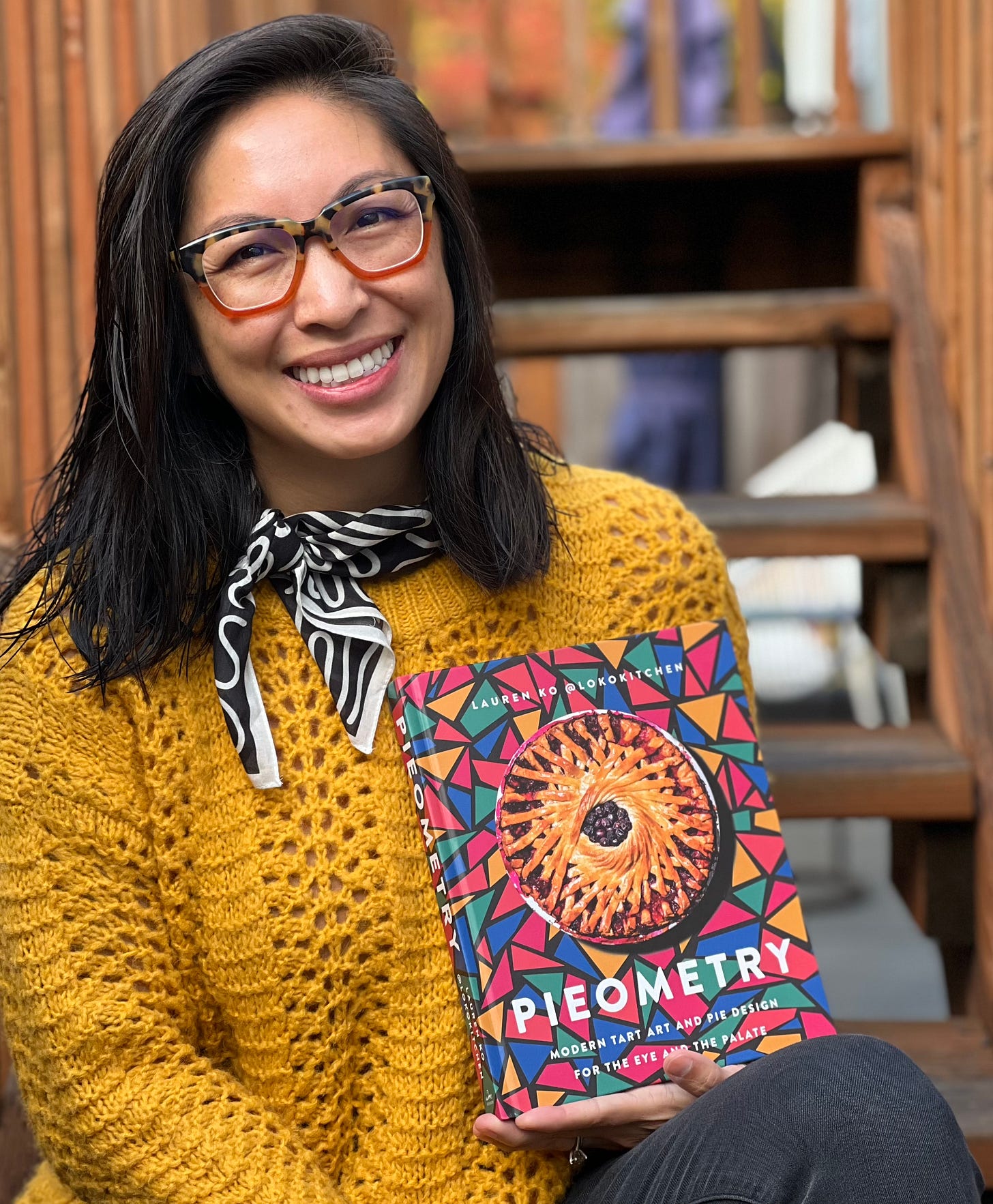


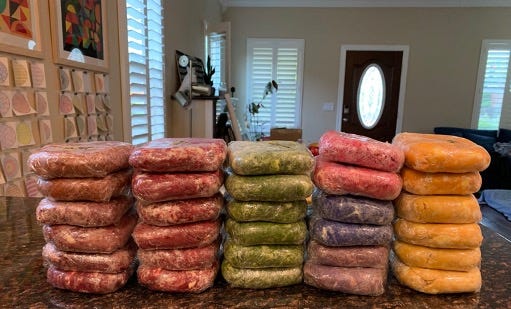
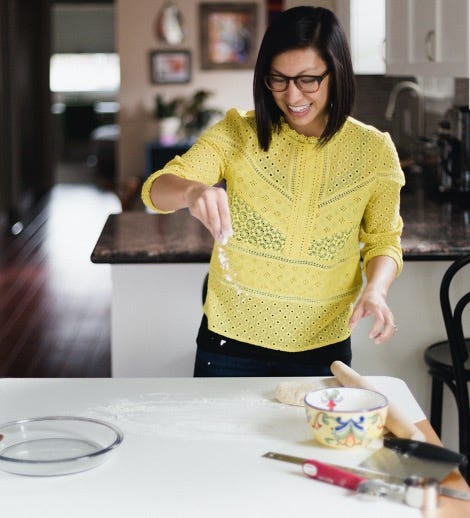
She's such an amazing artist! What a tasty medium!
Thank you for the introduction to Lauren's artistry. I am intrigued by her interesting combination of flavors and the fact that mangoes are tasty consumed green with salt
Who knew! My dilemma has always been coaxing them to ripen. I love pie, but have never been adept with the crust.